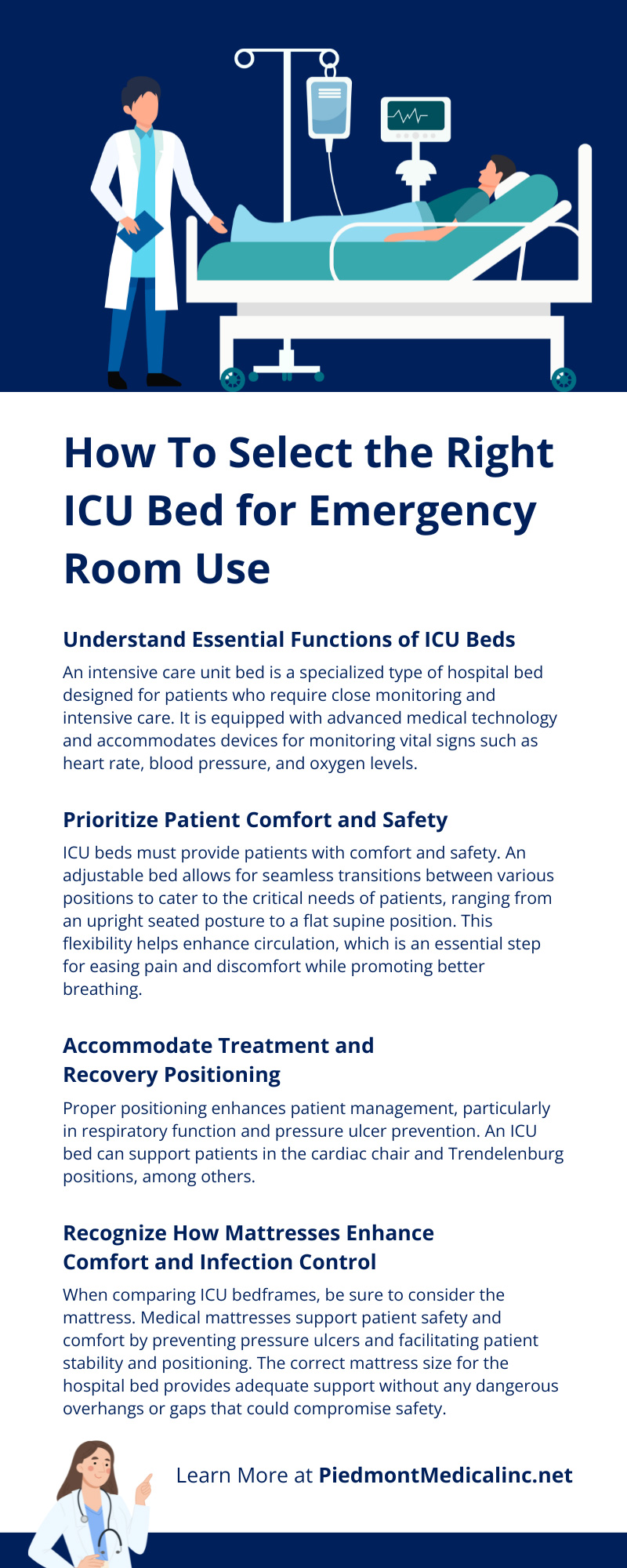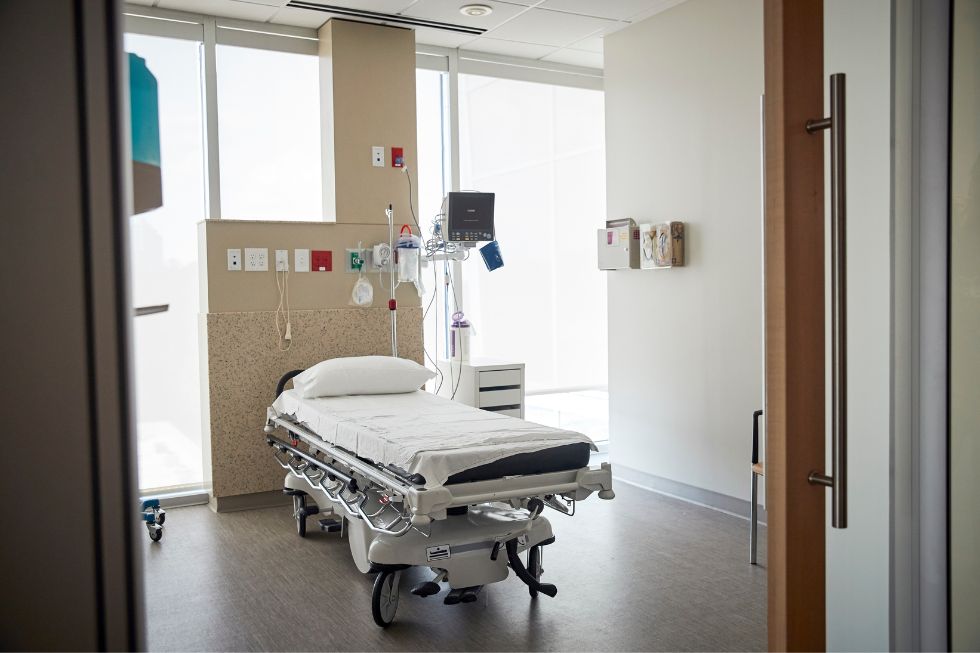The right emergency room hospital bed provides critical support for treatment and recovery. Intensive care unit (ICU) beds in the ER enhance the medical team’s capability to provide intensive monitoring and care. With advanced comfort, safety, and monitoring features, these beds ensure that patients receive the best support while allowing healthcare professionals to work with the utmost efficiency. Discover how to select the right ICU bed for emergency room use.
Understand Essential Functions of ICU Beds
An intensive care unit bed is a specialized type of hospital bed designed for patients who require close monitoring and intensive care. It is equipped with advanced medical technology and accommodates devices for monitoring vital signs such as heart rate, blood pressure, and oxygen levels. Regular hospital beds are typically used for general patient care, where continuous monitoring and immediate access to advanced life-supporting equipment may not be necessary.
Typically, an ICU bed offers more sophisticated functions, such as electrically adjustable height and position for patient comfort and ease of medical procedures. In contrast, general hospital beds can have manual or semi-electrical controls.
Prioritize Patient Comfort and Safety
ICU beds must provide patients with comfort and safety. An adjustable bed allows for seamless transitions between various positions to cater to the critical needs of patients, ranging from an upright seated posture to a flat supine position. This flexibility helps enhance circulation, which is an essential step for easing pain and discomfort while promoting better breathing.
High-quality ICU beds have easy-to-use controls that enable quick, smooth adjustments by healthcare professionals. Easier positioning improves healthcare efficiency and reduces the risk of injury for both the patient and medical staff.
Accommodate Treatment and Recovery Positioning
Proper positioning enhances patient management, particularly in respiratory function and pressure ulcer prevention. An ICU bed can support patients in the cardiac chair and Trendelenburg positions, among others.
Cardiac Chair for Cardiovascular Recovery
The cardiac chair position elevates the patient into a seated posture, facilitating easier breathing and interaction with visiting family or medical personnel. This position is essential for patients recovering from cardiac procedures, as it helps to reduce the stress on their hearts while simultaneously promoting circulatory efficiency.
Trendelenburg for Respiratory Support
The Trendelenburg position, involving a slight incline with the feet elevated above the head, improves venous return. This position can also aid in respiratory mechanics by relieving pressure from the diaphragm, which is a vital consideration for ICU patients with compromised lung function.
Recognize How Mattresses Enhance Comfort and Infection Control
When comparing ICU bedframes, be sure to consider the mattress. Medical mattresses support patient safety and comfort by preventing pressure ulcers and facilitating patient stability and positioning. The correct mattress size for the hospital bed provides adequate support without any dangerous overhangs or gaps that could compromise safety.
Emergency rooms are high-traffic areas with a significant risk of cross-contamination. Mattresses designed with impermeable materials not only mitigate this risk but also align with stringent hygiene protocols, ensuring a safer environment for both patients and healthcare practitioners. Look for mattresses that feature waterproof and antimicrobial surfaces that are easy to clean and maintain.
Get the Right Bed Size
The physical dimensions of the ICU bed affect the efficiency of medical care. A bed that is too large for the space can limit maneuverability and access around the area, which is vital for emergency response and patient care. On the other hand, a bed that’s too small may not adequately accommodate a wide variety of patients comfortably or provide the necessary support, diminishing patient comfort.
Consider the floor space the bed will occupy in the ER and how the bed will fit within the ER’s current layout. Additionally, the right bed size will provide sufficient room for healthcare professionals to conduct procedures without strain.
Facilitate Patient Transport
When selecting an ICU bed for the emergency room, consider how the bed can facilitate safe patient transport, such as from the ambulance bay or imaging center to other rooms. A patient transport critical care bed is a highly specialized hospital bed designed to ensure the safe and efficient movement of severely ill patients. For example, Stryker critical care beds feature advanced mobility options and compatibility with life-support equipment to maintain patient stability during transport.
The following ICU bed features make patient transport safer and easier:
- Integrated mobile technology: Built-in systems compatible with critical monitoring devices ensure uninterrupted patient care during movement within the hospital.
- Enhanced safety mechanisms: Beds with secure railings and braking systems prevent falls, collisions, and other accidents during transit.
- Durable, smooth casters: High-quality, smooth-rolling casters are a must-have for maneuvering beds through hospital corridors easily.
- Battery backup systems: A battery backup ensures that adjustable features and essential monitoring equipment remain operable, even during power outages.
Easily Add and Remove Medical Accessories
Medical accessories in the emergency room include critical devices like IV poles, oxygen tanks, and monitoring equipment. These accessories play a vital role in life-saving procedures and continuous patient care.
ER hospital beds must accommodate accessory customization to meet changing care requirements for each patient. Customizable accessory rails and mounting points keep life-saving devices securely attached and readily accessible. Tailoring the configuration of these accessories to each patient’s needs optimizes care and aids in the recovery process.
Consult End Users and Industry Experts
Medical equipment buyers can gain practical insight into the performance of ICU beds by consulting with healthcare professionals who use them in the ER. These individuals include nurses, doctors, and hospital technicians who can provide firsthand experience regarding the functionality and ergonomic design of ICU beds. Discussions with these professionals should cover how the beds interface with other medical equipment, ease of cleaning and maintenance, and patient comfort levels during care procedures.
Buyers should also engage with industry experts and suppliers who specialize in medical equipment manufacturing. They bring technical knowledge about the latest advancements in ICU bed design and the materials that comply with safety and performance regulations. Queries for the supplier should delve into the durability of materials used, warranty coverage, and the availability of replacement parts.
With the proper beds, healthcare professionals can ensure optimal care and efficient medical response in critical situations. Equip your ER with ICU beds that support patient comfort and safety while integrating smoothly with your existing ER layout. At Piedmont Medical, we carry a range of ICU beds that meet the highest standards for emergency care. Contact us today to find the right medical equipment for your facility.



Recent Comments